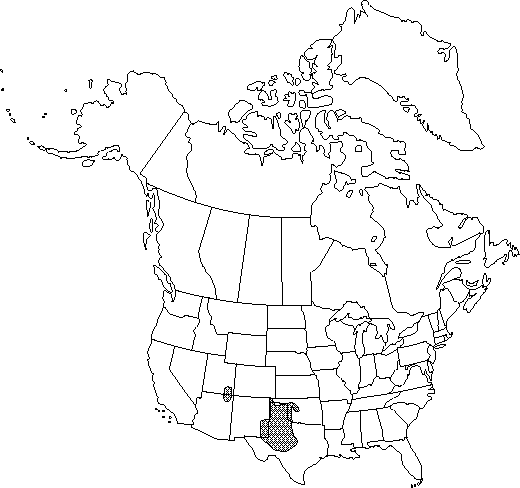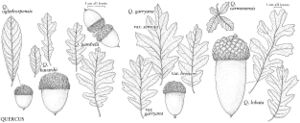Difference between revisions of "Quercus havardii"
Bull. New York Bot. Gard. 2: 213. 1901.
FNA>Volume Importer |
imported>Volume Importer |
||
| (3 intermediate revisions by 2 users not shown) | |||
| Line 9: | Line 9: | ||
|common_names=Havard oak | |common_names=Havard oak | ||
|special_status={{Treatment/ID/Special_status | |special_status={{Treatment/ID/Special_status | ||
| + | |code=W1 | ||
| + | |label= | ||
| + | }}{{Treatment/ID/Special_status | ||
|code=E | |code=E | ||
|label=Endemic | |label=Endemic | ||
}}{{Treatment/ID/Special_status | }}{{Treatment/ID/Special_status | ||
|code=F | |code=F | ||
| − | |label= | + | |label=Illustrated |
| − | |||
| − | |||
| − | |||
}} | }} | ||
|basionyms= | |basionyms= | ||
| Line 47: | Line 47: | ||
-->{{#Taxon: | -->{{#Taxon: | ||
name=Quercus havardii | name=Quercus havardii | ||
| − | |||
|authority=Rydberg | |authority=Rydberg | ||
|rank=species | |rank=species | ||
| Line 61: | Line 60: | ||
|publication title=Bull. New York Bot. Gard. | |publication title=Bull. New York Bot. Gard. | ||
|publication year=1901 | |publication year=1901 | ||
| − | |special status=Endemic; | + | |special status=W1;Endemic;Illustrated |
| − | |source xml=https:// | + | |source xml=https://bitbucket.org/aafc-mbb/fna-data-curation/src/2e0870ddd59836b60bcf96646a41e87ea5a5943a/coarse_grained_fna_xml/V3/V3_581.xml |
|genus=Quercus | |genus=Quercus | ||
|section=Quercus sect. Quercus | |section=Quercus sect. Quercus | ||
Latest revision as of 21:49, 5 November 2020
Shrubs, deciduous, low, forming clones 0.3-1.5 × 10 m, rhizomatous. Bark light gray, scaly-papery. Twigs brown or grayish, 1-2.5 mm diam., glabrous or densely short grayish or yellowish tomentulose, glabrate in age. Buds dark red-brown, subglobose, ca. 2 mm, sparsely pubescent. Leaves: petiole to 7 mm. Leaf blade green, often turning brownish with age, polymorphic, oblong or elliptic or sometimes lanceolate to oblanceolate or ovate to obovate, (30-)50-100 × (10-)20-50 mm, rather thick and hard, base rounded to cuneate, margins flat to revolute, at least some undulate, 2-3 rounded teeth on each side, secondary veins 5-8 on each side, much branched, apex broadly rounded, rarely acute; surfaces abaxially densely grayish or yellowish tomentulose or stellate-pubescent, sometimes only sparsely pubescent, secondary veins quite prominent, adaxially lustrous, very sparsely stellate-pubescent or glabrate, secondary veins very slightly if at all raised. Acorns solitary or paired, subsessile or on peduncle to 10(-18) mm; cup from deeply cup-shaped to goblet-shaped, 10-12 mm deep × 15-25 mm wide, enclosing 1/3-1/2 nut, base rounded or slightly constricted, margin very thin and smooth, scales reddish brown, triangular-ovate to long-acute, proximally moderately to markedly tuberculate, pubescent, often canescent, tips loosely appressed; nut brown, ovoid, 12-25 × 14-18 mm. Cotyledons distinct.
Phenology: Flowering spring.
Habitat: Deep, shifting or stabilized sand dunes, off deep sands in putative hybrid populations
Elevation: 500-1500 m
Distribution

N.Mex., Okla., Tex.
Discussion
Individual clones emerging to heights of 2-3 m from thickets occur sporadically across the Texas range of Quercus havardii and express some characteristics of Q. stellata, such as more deeply lobed leaves and smaller acorns. Such putative hybrids increase in frequency in the eastern part of the range of the species.
Material of Quercus havardii from the Navajo Basin of Utah and adjacent Arizona has been treated as Q. havardii var. tuckeri Welsh. Welsh followed J. M. Tucker (1970) and interpreted these intermediate populations as putative hybrids between Q. havardii and both Q. turbinella and Q. gambelii. Giving varietal rank, instead of nothospecies status, to such populations seems arbitrary, and it certainly is inconsistent with their putative hybrid origins.
